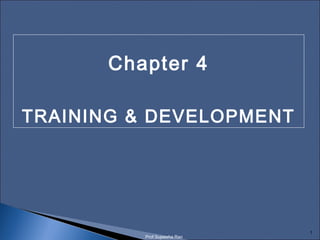
Chp 4 new- training & development
- 1. 1 Chapter 4 TRAINING & DEVELOPMENT Prof.Sujeesha Rao
- 2. 2 Introduction • Need for organizations to build and sustain competencies that would provide them with competitive advantage. •Knowledge era Human assets are valued highly. •Growth oriented organizations value training as a response to changing environment •Continues learning process in human development •Helps in development of one’s personality, sharpens skills and enhances effectiveness •It is an important and integral part of organizational renewal process
- 3. 3 Training and development •Training is a process through which a person enhances and develops his efficiency, capacity, and effectiveness at work by improving and updating his knowledge and understanding the skills relevant to his or her job. •Training and development •Training Vs. education •Training at different levels •Purpose of training •Learning curve •Transfer of learning Prof.Sujeesha Rao
- 4. 4 Functions of a training program •Acquiring knowledge •Change in attitudes •Helping to put theory into practice •Helps to evaluate abilities, competencies •Enhances problem solving and decision making ability •Improves performance Prof.Sujeesha Rao
- 5. 5 Importance & Need of training •Aids in new entrants attaining role clarity •Promotions •Prevents skill obsolescence •Improves quality and productivity •Meet organizational objectives •Improves organizational climate •Prevent accidents •To support personal growth and development Prof.Sujeesha Rao
- 6. 6 •Intention to learn from the participant •Reinforcement provided to the learner •Developing the potential from an individual’s point of view •Active participation of the trainee •Providing opportunities for practice •Transfer of learning to take place from a training program Prof.Sujeesha Rao
- 7. 7 What deficiencies, if any, does job holder have in terms of skills, knowledge, abilities, and behaviours? What behaviours are necessary? Is there a need for training? What are the strategic goals of the organization? What tasks must be completed to achieve goals? Prof.Sujeesha Rao
- 8. 8 Phase I – Needs assessment Phase II – Design & delivery of T&D Phase III - Evaluation Prof.Sujeesha Rao
- 9. 9 Phase I – Needs assessment Determines the organization’s true needs and the training programs necessary to meet them •Organisational analysis •Operations analysis •Individual analysis Advisory committees, Assessment centres, Attitude survey, Group discussions, Questionnaires, Skills test, Observations of behaviour, Performance appraisals, Performance documents, Exit interviews Prof.Sujeesha Rao
- 10. 10 Phase II – Design & delivery of T&D ◦Training design principles of learning Motivation Participation Feedback Organisation Repetition Application ◦Training delivery ◦On-the-job training (OJT) ◦Away-from-the-job training ◦A T&D plan & implementation Prof.Sujeesha Rao
- 11. 11 Phase III – Evaluation ◦ Levels of evaluation: How did participants react? What did participants learn? How did participants’ behaviour change? What organisational goals were affected? ◦ Applying evaluation strategies Prof.Sujeesha Rao
- 12. 12 Training methods on the job /offTraining methods on the job /off the jobthe job On the job training methods are: •Job instruction training •Vestibule training •Training by supervisors •Coaching on the job/Simulation •Apprenticeship •Job rotation Prof.Sujeesha Rao
- 13. 13 Off the job training methods: • Lectures • Conferences • Case studies • Role play • Programmed instruction training • T group/Sensitivity training Prof.Sujeesha Rao
- 14. 14 • Criteria for evaluation are: • Objectives of the program • Cost-benefit analysis • Results obtained • Areas of improvement • Resources/ staff required • Methods of evaluation would be: • Questionnaires, projects, tests, interviews, observations or participation and discussions. Prof.Sujeesha Rao
- 15. 15 • Cross cultural approaches • Maintenance of standards • Interaction with learners • Use of technology – CD ROMs, WAN, CBT, WBT • E-learning – types • Informal learning, self-paced, leader lead learning and performance support tools Prof.Sujeesha Rao
- 16. 16 • Quality improvement programmes • Technological change-related programmes • Customer service T&D programmes Prof.Sujeesha Rao
- 17. 17 • Training is not equally distributed to all employees • Expenditure allocated to training is inadequate • Mismatch between theory and practice • Benefits of training are not immediately realized • Supporting contextual systems needs to be provided in organizations • Top management needs to support the philosophy of training in spirit Prof.Sujeesha Rao
- 18. 18 Chapter 4 B Executive Development Programs
- 19. 19 Organizational environment Organizational strategy/objectives Conduct of the training program Training needs assessment Identifying competency gaps Training plan STAGE 1 STAGE 3 STAGE 2
- 20. 20 •Decision making skills •Interpersonal skills •Job knowledge •Organizational knowledge •Specific individual needs •General knowledge Competency Development Areas ofCompetency Development Areas of EDPEDP
- 21. 21 Factors in designing an EDPFactors in designing an EDP •Learning characteristics and its applicability to design •Knowledge of results •Reward mechanism •Individual difference of the learners •Application to the work environment •Meeting organizational goals thru content design
- 22. 22 Methods of EDPMethods of EDP
- 23. 23 Evaluation of EDP is important for the following reasons: • Improving the quality of training and development process • Improving the efficiency and competency of trainers • Make improvements in the system to make it more responsive • Aligning the training objectives to organizational objectives • Evaluating the ROI on account of training and development • Changing the perception of the management as to regard training as an investment EvaluationEvaluation
